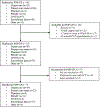Evaluation of the POP-UP programme: a multicomponent model of care for people living with HIV with homelessness or unstable housing
- PMID: 34076613
- PMCID: PMC8186736
- DOI: 10.1097/QAD.0000000000002843
Evaluation of the POP-UP programme: a multicomponent model of care for people living with HIV with homelessness or unstable housing
Abstract
Objective: Homelessness is the greatest risk factor for HIV viremia in San Francisco. Innovative care models for people with HIV (PWH) with homelessness or unstable housing (HUH) are needed to address this inequity. We developed a novel low-barrier clinic-based program for PWH-HUH in an urban safety-net clinic ('POP-UP') and report outcomes on care engagement and viral suppression.
Design: A prospective cohort study.
Setting: San Francisco General Hospital HIV Clinic (Ward 86).
Participants: We enrolled PWH who are HUH, viraemic and for whom usual care is not working (at least one missed primary care appointment and at least two drop-in visits at Ward 86 in the last year).
Intervention: POP-UP provides drop-in comprehensive primary care, housing assistance and case management, financial incentives and patient navigation with frequent contact.
Main outcome measures: We describe uptake of eligible patients into POP-UP, and cumulative incidence of antiretroviral therapy (ART) initiation, return to care and virologic suppression 6 months post-enrolment, estimated via Kaplan--Meier.
Results: Out of 192 referred patients, 152 were eligible, and 75 enrolled. All 75 were off ART and viraemic; 100% had a substance use disorder; and 77% had a mental health diagnosis. Over three-quarters restarted ART within 7 days of enrolment, and 91% returned for follow-up within 90 days. The cumulative incidence of viral suppression at 6 months was 55% (95% confidence interval 43-68).
Conclusion: A novel care model for PWH-HUH demonstrates early success in engaging viraemic patients in care and improving viral suppression. Low-barrier, high-contact primary care programmes offering comprehensive services and incentives may improve outcomes for this vulnerable population.
Copyright © 2021 Wolters Kluwer Health, Inc. All rights reserved.
Conflict of interest statement
No Conflicts of Interest to report


